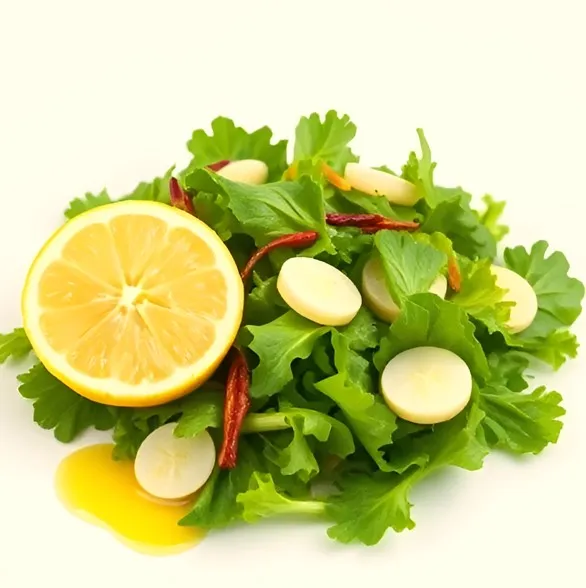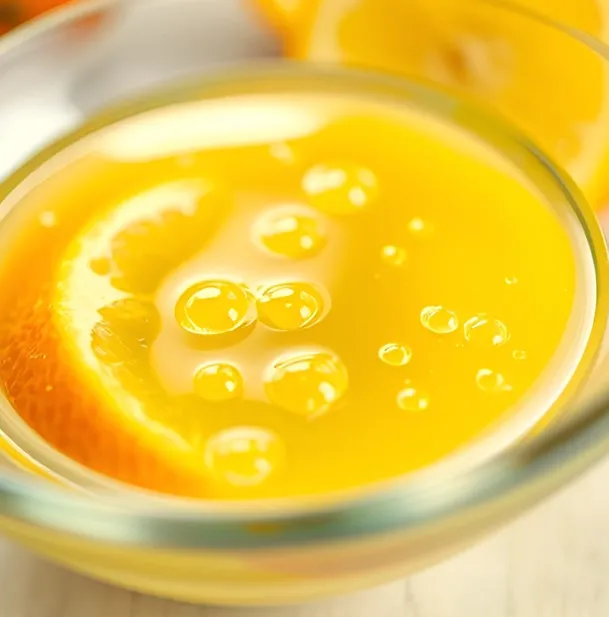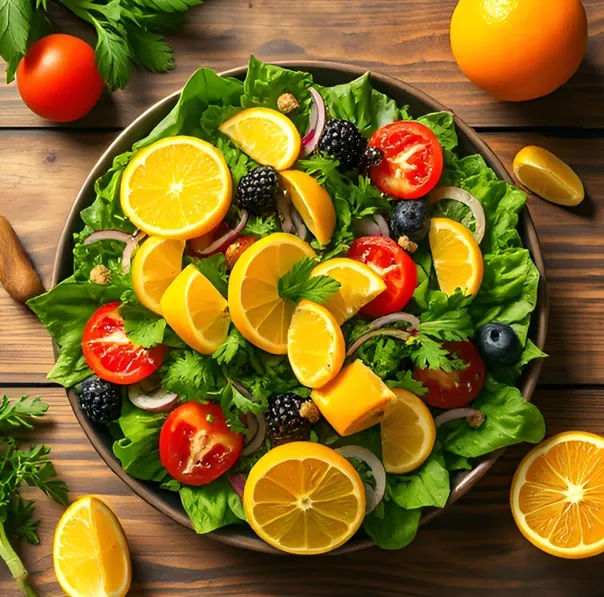In today’s modern kitchen, where fast food and heavily processed options often steal the spotlight, a refreshing, homemade dressing can transform any meal into something extraordinary. With its vibrant flavors and versatility, the citrus vinaigrette is a must-have for anyone wanting to add a burst of brightness to fresh greens, roasted vegetables, or even grilled proteins. I invite you on a culinary journey as we unpack everything there is to know about citrus vinaigrette, share the secrets behind its perfect balance, offer step-by-step recipes including a nod to Ina Garten’s famous version, and answer some frequently asked questions about making this tangy dressing from scratch.
Table of Contents
What Is Citrus Vinaigrette?
At its core, citrus vinaigrette is a salad dressing bursting with the tang of citrus fruits combined with the rich, smooth texture of quality olive oil. Unlike heavier dressings loaded with cream or mayonnaise, citrus vinaigrette emphasizes freshness and acidity in every drop. Typically, it features a blend of citrus juice—often lemon, lime, or orange—with extra-virgin olive oil, salt, pepper, and sometimes a touch of honey or mustard to round out the flavors. The result is a light, vibrant dressing that enhances the natural goodness of your ingredients rather than overpowering them.
From summer picnics to elegant dinner parties, citrus vinaigrette adds a layer of sophistication and healthy fats to your meals. Its popularity is rooted in the perfect union of simplicity and flavor. This dressing is not only easy to whip up quickly but also highly customizable to suit your palate or the seasonal produce available in your region.
The Science Behind a Great Vinaigrette
Before diving into specific recipes, it’s important to understand the simple science that makes a vinaigrette work so well. Fundamentally, a vinaigrette is an emulsion—a temporary mixture of two ingredients that usually don’t combine, like oil and water (or in this case, citrus juice). There are two fundamental ingredients used to make a vinaigrette: an acid and oil. The acid, provided by citrus juice or vinegar, delivers tanginess, while the oil, most commonly extra-virgin olive oil, gives the dressing its rich, smooth mouthfeel. Optional ingredients such as salt, pepper, honey, or mustard serve as emulsifiers or flavor enhancers, helping to stabilize the mixture and add complexity to the final product.
When you whisk together these ingredients rapidly, you temporarily combine them into a smooth dressing. With a little extra effort—using a blender or a tight-sealing jar—you can create a more stable emulsion that lasts longer on your salad and doesn’t separate quickly.
The Benefits of Using Citrus Vinaigrette
Citrus vinaigrette is celebrated not only for its refreshing flavor but also for its numerous benefits, both culinary and nutritional. Here are some of the reasons to include this dressing in your culinary repertoire:
- Health Benefits: The combination of extra-virgin olive oil and citrus juice offers heart-healthy fats and a powerful dose of vitamin C. These ingredients help reduce inflammation, spotlight antioxidants, and promote overall wellness.
- Versatility: Whether you’re dressing a simple green salad, a hearty grain bowl, or even a marinated piece of fish, this vinaigrette adapts effortlessly to the dish. Its zesty flavor complements rather than overshadows delicate ingredients.
- Customizability: The basic formula is a blank canvas for experimentation. Swap lemon juice for grapefruit or add fresh herbs like basil or tarragon for a twist on the traditional recipe.
- Ease and Speed: With straightforward ingredients and a simple mixing process, the citrus vinaigrette can be prepared in minutes, making it ideal for weeknight dinners or last-minute gatherings.

How to Make a Basic Citrus Vinaigrette
Crafting your homemade citrus vinaigrette is both an art and science. Here’s a basic recipe that you can adjust to suit your taste:
Ingredients
• 1/3 cup of extra-virgin olive oil
• 3 tablespoons of freshly squeezed citrus juice (lemon, orange, or a combination)
• 1 teaspoon of Dijon mustard (to act as an emulsifier)
• 1 teaspoon of honey (optional, for a touch of sweetness)
• Salt and freshly ground black pepper to taste
Instructions
Start by pouring the freshly squeezed citrus juice into a bowl. Gradually add a teaspoon of Dijon mustard and mix until it’s well incorporated, as the mustard helps blend the oil and vinegar together. Next, slowly drizzle the extra-virgin olive oil into the bowl while whisking constantly; this continuous mixing helps create a stable emulsion. Finally, add the honey if you desire a sweeter dressing and season with salt and freshly ground black pepper. Taste and adjust the seasoning if needed. In just a few minutes, you have a delicious citrus vinaigrette that’s ready to elevate your salads.
Ina Garten’s Inspired Citrus Vinaigrette
For those who admire celebrity chefs and appreciate a refined touch in the kitchen, Ina Garten’s citrus vinaigrette is a household favorite that has earned a reputation for its balanced and elegant flavors. While Ina Garten’s original recipes are often guarded secrets passed along with her warm personality, several versions inspired by her techniques circulate among home cooks.
One popular Ina Garten-inspired version goes like this:
Ingredients
• 1/4 cup extra-virgin olive oil
• 2 tablespoons freshly squeezed lemon juice
• 2 tablespoons freshly squeezed orange juice
• 1 teaspoon minced shallots
• 1/2 teaspoon sugar or honey
• Salt and pepper, to taste
Directions
Begin by combining the lemon and orange juices with the minced shallots in a small bowl. Let the mixture sit for about 5 minutes to allow the shallots to soften and release their subtle sweetness into the citrus blend. Then, whisk in the olive oil gradually until you achieve a smooth, emulsified dressing. Stir in the grain of salt, add a dash of black pepper, and mix again to combine. Many fans of Ina Garten appreciate how this vinaigrette highlights the natural candor of citrus while adding a whisper of sweetness and a touch of luxurious olive oil, making it the perfect accompaniment to a light mixed salad or even as a marinade for chicken.
The Versatile Appeal of Citrus Vinaigrette
Though the basic formula for citrus vinaigrette is delightfully simple, its applications extend far beyond a typical green salad. Here are a few creative ways to incorporate a citrus-based dressing into your meals:
Marinade for Grilled Protein: The bright acidity of citrus can cut through the richness of grilled chicken, fish, or steak, adding a layer of sophistication to your dish. Marinate your proteins in a mixture of citrus vinaigrette for at least 30 minutes to allow the flavors to penetrate deeply.
Roasted Vegetable Glaze: Toss roasted or steamed vegetables such as asparagus, broccoli, or cauliflower in a generous drizzle of citrus vinaigrette to transform them into a more vibrant and palatable side dish. The tang of the citrus pairs particularly well with earthy vegetables, making them shine.
Grain Bowls and Pasta Salads: Incorporate a spoonful of citrus vinaigrette in your quinoa, farro, or pasta salads for a zesty twist. The bright flavors contrast beautifully with the more neutral grains, providing a refreshing burst in every bite.
Dipping Sauce for Fresh Breads: Consider serving a small bowl of citrus vinaigrette alongside crusty artisan breads or as a dip for crudités at your next gathering. This alternate use highlights your culinary creativity while offering your guests an unexpected flavor experience.

Tips for Mastering the Perfect Emulsion
Creating a flawless vinaigrette might seem elementary at first, yet achieving that perfectly balanced, stable emulsion is a craft all its own. Here are a few pro tips to help you perfect your citrus vinaigrette:
It is essential to use quality ingredients. Extra-virgin olive oil contributes not only healthy fats but also a rich, complex flavor that sets this dressing apart from store-bought alternatives. Always opt for freshly squeezed citrus juice rather than bottled varieties, as the natural acids and brightness are much more vivid.
Temperature can affect the emulsion process. A slightly warmer room can help the oil and citrus juice combine more smoothly. If your ingredients are too cold, especially after being stored in the refrigerator, the emulsion might not form properly.
Using an immersion blender or tightly sealed jar to shake vigorously can produce a more stable emulsion, ensuring that the oil and citrus juice don’t separate immediately. While hand whisking works fine, investing in a small blender might be worthwhile if you plan to make dressings frequently.
Don’t forget to taste as you go. Citrus vinaigrette is all about balance. If the dressing tastes too sharp, a touch more olive oil or a tiny bit of honey can smooth its edge. Conversely, if the flavors are too mellow, a squeeze more citrus juice or a pinch of sea salt can amplify the zing.
Exploring Variations: The Art of the Lemon Vinaigrette
While citrus vinaigrette can be made with a variety of citrus fruits, lemon vinaigrette deserves a special mention on its own. Thanks to its bright, sharply acidic taste, lemon vinaigrette has long been a staple in salad bars and kitchens alike.
To make a lemon vinaigrette, start with the basic essence of a citrus vinaigrette but let the lemon take center stage. The process is quite similar:
Begin by juicing a fresh lemon to extract about two tablespoons of juice. In a bowl, combine this juice with a teaspoon of Dijon mustard and a teaspoon of honey to help balance out the tartness. Slowly whisk in 1/3 cup of extra-virgin olive oil until you form a well-emulsified mixture. Season generously with a pinch of salt and a few grinds of freshly cracked pepper.
The resulting lemon vinaigrette is crisp, tangy, and versatile enough to elevate a simple arugula salad, drizzle over steamed vegetables, or even be used as a light marinade. Consider adding zest for an extra hit of lemon flavor if you’re looking to intensify the citrus kick even further.
Seasonal Considerations and Ingredient Variations
The beauty of a homemade citrus vinaigrette lies in its adaptability. Depending on the season, you can tweak the ingredients lightly to reflect what’s available locally or to change the flavor profile subtly. For instance, during late fall or winter, oranges dominate the citrus offerings. An orange vinaigrette, mixed with a hint of rosemary, can provide a warming counterpoint to the crisp winter air and pair beautifully with roasted root vegetables.
Springtime and summer, when lemons and limes are at their peak, deserve a vibrant, tangy vinaigrette perfect for garden-fresh salads. Try experimenting by blending a mix of lemon and lime juices with a dash of white wine vinegar for an added layer of acidity and complexity.
In any case, integrating seasonal herbs like basil, mint, or tarragon can enrich your vinaigrette and add an aromatic herbaceous note that elevates the overall dish. These subtle adjustments not only keep the recipe exciting but also demonstrate the power of fresh ingredients to transform a simple dressing into a gourmet experience.
Mastering the Fusion of Flavors
Creating a list of recipes for citrus vinaigrette can spark a wave of creativity in your kitchen. Experiment with combinations such as adding fresh minced garlic to give the dressing an extra depth of flavor or incorporating a hint of chili for those who prefer a spicy kick. Some chefs even blend in a splash of balsamic vinegar along with the citrus juice to achieve a complex layering of acidity that fascinates the palate.
For anyone who loves to entertain, setting up a “dressing station” where guests can mix their own customized vinaigrettes can be a fun interactive activity. Provide a selection of citrus juices, a variety of oils, seasonings, and herbs, and let your guests experiment until they find their perfect blend. This approach not only showcases your culinary skills but also makes the meal interactive and memorable for everyone involved.
Troubleshooting Your Vinaigrette
While citrus vinaigrettes are renowned for their simplicity, there are occasional mishaps every kitchen enthusiast might encounter. Separation is a common issue given the volatile nature of emulsions. If your vinaigrette splits, don’t panic; simply whisk or shake it vigorously again. Another tip is to add a small amount of a secondary emulsifier, like a dab more Dijon mustard, which can help bind the oil and citrus juice together more effectively.
If you find the dressing too acidic for your liking, gradually incorporate more olive oil or even a teaspoon of water to ease the intensity. Balancing a vinaigrette is very much like tuning an instrument: with patience and slight adjustments, you can achieve culinary harmony. Keeping these troubleshooting tips in your back pocket will ensure that your citrus vinaigrette always turns out just right.
Pairing Your Citrus Vinaigrette with the Perfect Dishes
A well-made citrus vinaigrette has the power to elevate a variety of dishes. Imagine a vibrant arugula salad adorned with shaved parmesan and toasted pine nuts, drizzled with this tangy dressing. The crisp, peppery arugula harmonizes with the bright acidity, while the nutty notes from the pine nuts create a delightful contrast. Alternatively, try it on a warm quinoa salad featuring roasted bell peppers, black beans, and fresh cilantro. The vinaigrette not only breaks through the density of grains and legumes but also brightens up the flavors, making every bite memorable.
For a more unconventional approach, consider using the citrus vinaigrette as a finishing drizzle on grilled seafood or chicken. The dressing’s acidity can counterbalance the smoky char of the grill while adding an extra layer of sophistication to your dish. Additionally, incorporating this dressing into your rice paper rolls or as a sauce for cold soba noodles makes for an innovative twist in Asian-inspired culinary creations.
Frequently Asked Questions (F.A.Q.)
What is citrus vinaigrette made of?
Citrus vinaigrette is typically made of freshly squeezed citrus juice (such as lemon, lime, or orange), extra-virgin olive oil, and a balancing agent like Dijon mustard or honey that helps to emulsify the oil with the citrus. Seasonings such as salt and black pepper are essential to round out this dressing’s tangy flavor.
How do you make Ina Garten citrus vinaigrette?
While Ina Garten’s exact recipe remains a closely held secret, many chefs have recreated a version inspired by her style. Begin with a blend of lemon and orange juices combined with minced shallots. Let the shallots infuse the citrus mix for a few minutes before intentionally emulsifying with high-grade olive oil. A dash of sugar or honey, followed by seasoning with salt and pepper, then delivers a refined, flavorful vinaigrette reminiscent of Ina Garten’s culinary charm.
What are the two fundamental ingredients used to make a vinaigrette?
The two fundamental ingredients are the acid—be it citrus juice or vinegar—and the oil. These two components form the base of any vinaigrette. They are often complemented by additional emulsifiers such as mustard or honey, along with seasonings that enhance the depth and flavor of the dressing.
How do you make a lemon vinaigrette?
Making a lemon vinaigrette starts with extracting fresh lemon juice, which gives the dressing its bright, tangy base. Mix the lemon juice with a dab of Dijon mustard and a touch of honey if a slight sweetness is desired. Slowly whisk in extra-virgin olive oil to form a stable emulsion. Finally, season with salt and cracked black pepper. This simple yet vibrant dressing pairs perfectly with greens, grains, and even grilled dishes.
Conclusion: Embrace the Citrus Revolution
In our busy lives, embracing simplicity can lead to remarkable culinary moments. Citrus vinaigrette is a testament to the idea that great taste often lies in simple, high-quality ingredients combined in just the right way. Whether you opt for a classic blend of lemon juice and olive oil or an elevated take inspired by Ina Garten, you’re inviting fresh, invigorating flavors into your kitchen.

